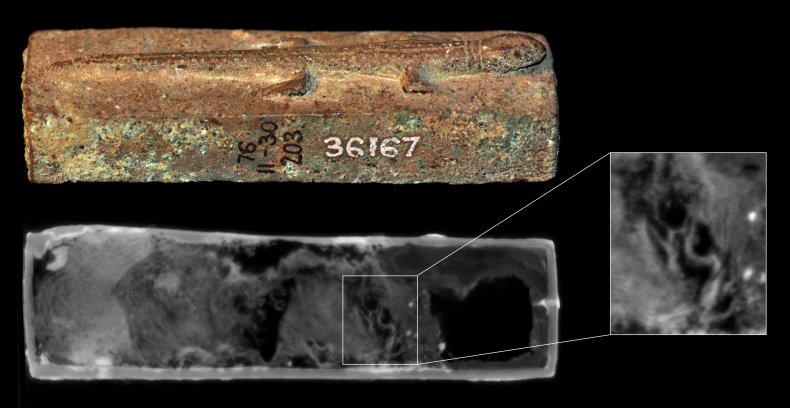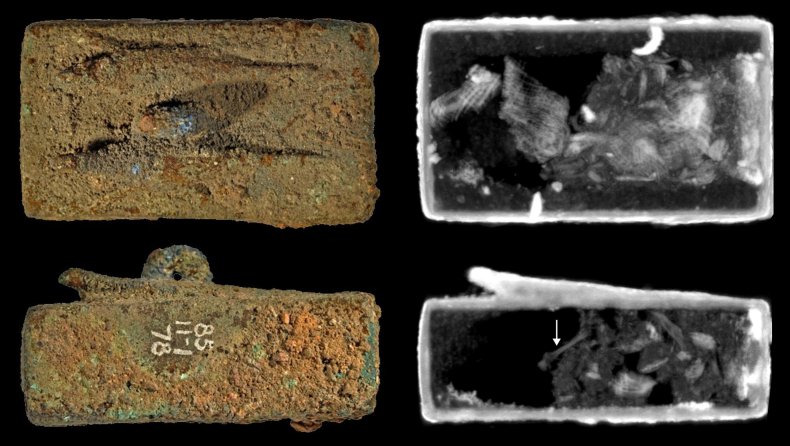Secrets of Sealed Egyptian Animal Coffins Revealed for the First Time
Scientists at the British Museum in London have used cutting-edge technology to see inside six ancient Egyptian animal coffins that have remained sealed for over two millennia.
The study, which was published in the journal Nature Scientific Reports on April 20, provides insight into the religious rituals and mummification practices that took place in ancient Egypt.
"It is rare for these metal coffins to have survived intact," Daniel O'Flynn, an X-ray imaging scientist at the British Museum and first author on this paper, told Newsweek.

Animal statues, or votive boxes with animal figurines, are often found in religious complexes from ancient Egypt, but it is difficult to analyze their contents without damaging the artifacts and what might lie inside.
"To further our knowledge of ancient Egyptian mummification, we were very interested to understand the contents of this group of sealed coffins, placed inside thousands of years ago," O'Flynn said. "With neutron imaging we were able to reveal lizard remains and textile wrappings within these coffins [...which] suggests that they were wrapped before being placed inside the boxes."
During the first millennium BCE, it was not uncommon for cats, dogs, lizards and other reptiles to be mummified. These animal remains were often believed to be physical incarnations of the gods, or may have acted as some sort of votive offering or ritual performance.
"The lizards placed in these coffins were mummified as part of religious practices and beliefs that particularly thrived in the first millennium BC," O'Flynn said. "Lizards, like snakes and eels, were particularly associated with ancient Egyptian solar and creator gods such as Atum and Amun-Ra."

The six coffins in this study—which have been dated to somewhere between 664 and 250 BCE—are all sealed and each is topped with a figurine, representing either a lizard or a human-eel-cobra hybrid. "Our aim when carrying out research into the British Museum collection is to be minimally invasive," O'Flynn said. "It was not an option for us to physically open the coffins, which would have damaged the coffins themselves as well as potentially destroying their contents."
Usually, so-called non-invasive imaging can be done using the same techniques doctors use to peer inside the human body: an X-ray. However, in this case, the X-rays were unable to get through the thick metal walls of the coffins. Therefore, the team had to come up with an alternative solution.
"Neutrons have properties which allow them to pass through some metals more easily than X-rays, and they are effective at seeing organic material," O'Flynn said.
Therefore, by firing neutrons at the sealed coffins and measuring the extent to which they were scattered and absorbed, the researchers were able to "see" inside.
Previous studies have found the bones of shrews, snakes and cats, among animals, inside similar votive boxes and figurines. However, many of these artifacts were discovered in pieces, with their contents incomplete or absent. That is why these six sealed artifacts are so unusual.

"We hope to extend this study to more sealed metal coffins and containers in the British Museum collection now that we have seen the effectiveness of neutron imaging for revealing hidden contents and understanding ancient manufacturing practices," O'Flynn said. "This technique could also be applied to other metal objects, for example, statues, to understand how they were made and expand our knowledge of ancient metalworking technology."
References
D. O'Flynn et al., Neutron tomography of sealed copper alloy animal coffins from ancient Egypt, Nature Scientific Reports, April 20 2023, DOI: 10.1038/s41598-023-30468-4








